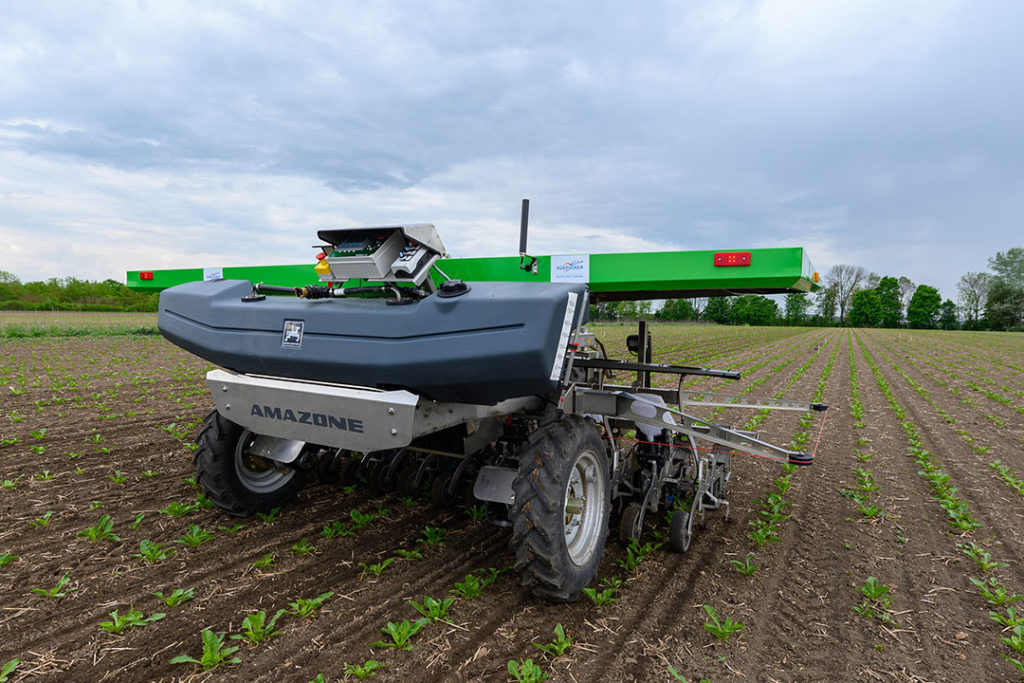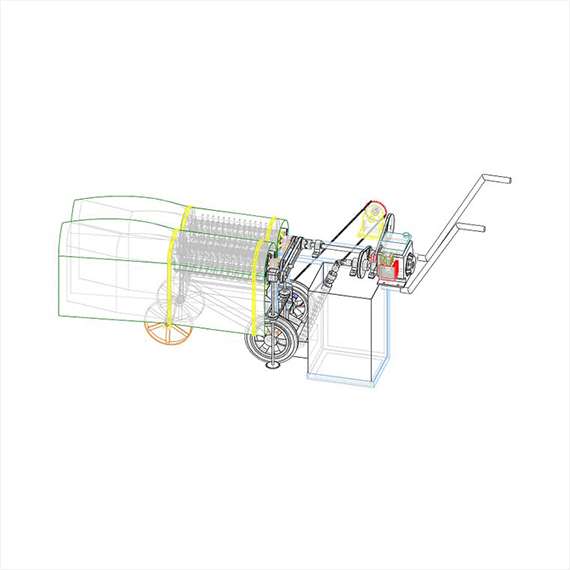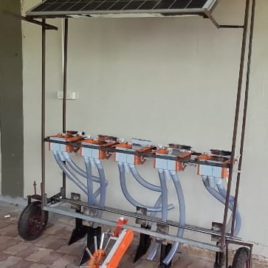This domain begins with the student’s survey on the farmer’s field to understand the mechanization-related problems they face.Based on their feedback, they will find the solution through smart technology. In order to get this, students will be taught concepts of farm machinery design and applications of sensors and actuators to make the machine smart. Making of 3D models of implements/machines and their simulation using Dassault software like CATIA and SOLIDWORKS will be practiced. Machine learning tools i.e. PYTHON and MATLAB will be taught. In addition, the students will beskilled in piloting the drone. Prominently, students will go through the training/internship program in domain-specific organizations i.e. tractor and farm machinery testing and training centers to understand the depth of the domain. After learning all these, students will take the project to develop a prototype of smart agricultural machinery and test it under actual field conditions.
Domain Track: Smart Farm Machinery
Course Attendees
Still no participant
Course Reviews
Still no reviews
The objectives of this domain is to make student learn that how the smart agricultural machinery can be developed based on the farmers feedback and field survey. The students will be able to understand the use of sensors and actuators based on the machine requirement. Students will be able to operate and test the agricultural machinery. Track Total Credits (T-P-P): (6-9-13) 28 Credits
Courses Division
Domain Track Objectives:
Domain Track Learning Outcomes:
Career scope:
Domain Syllabus:
1. Product Development Brief (0-2-1)
- 1.1 Customer or User Requirement for Specification (Gate 0)
- 1.2 Requirement gathering and feasibility study of the project
- 1.3 Understanding users’ motivations and to gather deep insights about a product
- 1.4 Challenges and benefits of the products
- 1.5 Understanding the product through literature survey and available resources
- 1.6 Market analysis of existing products
- 1.7 Finalizing the product specification
- 1.8 Preparing a project plan
2. Sensors, Actuators and ROS (2-2-0)
- 2.1 Sensors: GPS, GSM, Bluetooth, Tilt
- 2.2 Biometric, Pulse bit.
- 2.3 Temperature, Humidity.
- 2.4 Actuators: DC Motor.
- 2.5 Stepper motor
- 2.6 Servo motor
- 2.7 Solenoid valve
- 2.8 Speed control of motors
- 2.9 Controller: Arduino
- 2.10 Sensor communication and data fetching.
- 2.11 Arduino programming with sensors.
- 2.12 Controlling of actuator using sensors and programming.
- 2.13 Operation and control of servo motor
- 2.14 Operation and control of stepper motor
- 2.15 Operation control of DC motor
- 2.16 Output devices solenoid valves, relay, plunger
- 2.17 ROS & C++
- 2.18 What is Ubuntu & ROS.
- 2.19 Requirement and application of ROS.
- 2.20 ROS based simulation of Turtlbot.
- 2.21 Adding of robot with wheel & sensor.
- 2.22 Placing robot inside Gazebo.
- 2.23 Ubuntu basic command.
- 2.24 Installation of Ubuntu, ROS & Gazebo.
- 2.25 Turtlbot control application.
- 2.26 Gazebo based robot control and simulation.
- 2.27 Python and C++ based programming to control robot.
3. Design of Farm Machinery (2-0-1)
- 3.1 Basic design principles of farm machines,
- 3.2 Implements and tools.
- 3.3 Design of primary and secondary tillage implements,
- 3.4 Design of M.B. Plough
- 3.5 Design of Disc Plough,
- 3.6 Design of cultivator
- 3.7 Design of rotavator.
- 3.8 Design of seeders,
- 3.9 Design of planters,
- 3.10 Design of transplanting machines,
- 3.11 Design of fertilizer distributors.
- 3.12 Design of intercultural equipment,
- 3.13 Design of plant protection equipment.
- 3.14 Design of harvesting machines,
- 3.15 Design of threshing machines for cereals and pulses.
- 3.16 Design of chaff cutting unit,
- 3.17 Design of cleaning and grading unit,
- 3.18 Presentation on design of smart farm machinery.
4. Piloting a Drone (1-2-0)
- 4.1 Recognizes DGCA Safety Regulations & amp;
- 4.2 Develop safety attitude while flying Drones.
- 4.3 Identifies & amp; selection of different types of Drones & amp;
- 4.4 Fundamentals of Flight (Aerodynamics),
- 4.5 ATC procedures & amp;
- 4.6 Radio Telephony,
- 4.7 Different regulations of DGCA,
- 4.8 Civil Aviation Requirements,
- 4.9 Weather and meteorology.
- 4.10 Develop and apply knowledge of Airframes& amp;
- 4.11 Electric motors Propellers
- 4.12 Identification Selection of Electronic Speed Controllers (ESC)
- 4.13 Flight Controllers for Drones
- 4.14 Recognizes application of Batteries, Chargers, Connectors, Transmitters
- 4.15 Receivers, Cameras, GimbalsOther payloads.
- 4.16 Application of knowledge of Ground Control Stations FPV
- 4.17 Perform Assembling
- 4.18 MRO & battery care of Drones
- 4.19 Identification & selection of basic operating features of a Drone Flight Simulator
- 4.20 Fly a Drone with instructor and then perform solo flight (Virtual reality training & live Drone flying).
- 4.21 Carry out entire flying operations from pre-flight
- 4.22 Checks to after flight checks while flying a drone in simulator training & live training.
5. PLM using Dassault Tools (1-2-0)
- 5.1 System Engineering Dymola
- 5.2 Finding energetic dimension of the desired product
- 5.3 Designing system and subsystem using behaviour modelling work bench
- 5.4 Getting familiar with Dymola- modellica library.
- 5.6 Understanding the behaviour of the model through input n output data
- 5.7 Customizing the product properties
- 5.8 System Integration with product dimension.
- 5.10 Functional and logical design of integrated product in system engineering.
- 5.11 3-D Model using CATIA
- 5.12 CATIA part design of different components
- 5.13 Surface designing for creating high end complex design
- 5.14 Assembly Designing of the complete product
- 5.15 Wire routing and entire harnessing of the design.
- 5.16 Mechanical system Designing of the product
- 5.17 CATIA live rendering
- 5.18 Behaviour experience of the complete product.
- 5.19 Design validation/Simulation using Simulia
- 5.20 Simulation using Simulia
- 5.21 Classification of simulation
- 5.22 Structural simulation, Thermal simulation and both
- 5.23 Linear and non linear analysis
- 5.24 CFD Analysis, Fatigue, Durability
- 5.25 Explicit Analysis, Crash Analysis(Abaqus
6. Testing of Farm Machinery (0-2-1)
- 6.1 Introduction to testing of agricultural implements in actual field conditions.
- 6.2 Test codes for agricultural machines.
- 6.3 Testing of seeding machine
- 6.4 Testing of weeding machine
- 6.5 Testing of plant protection equipment,
- 6.6 Testing of crop harvester
- 6.7 Testing of threshing machines.
- 6.8 Testing of self-propelled combine harvester i.e. standard header, stripper header.
- 6.9 Testing of power tiller drawn tillage
- 6.10 Testing of tractor PTO shaft
- 6.11 Draw bar performance evaluation.
- 6.12 Testing of tractor wheels and hydraulic system
- 6.13 Testing of tractor systems cooling system, Brake system etc.
7. Product Development Project (0-0-8)
- 7.1 To develop a DIGITAL product and validate it and innovate using Catia/Simulia/Dymola Tools in Dassault 3 D experience.
Session Plan for the Entire Domain:
1. Design Thinking and Managing Innovation Through GATE Process (1-2-0)
- Session 1 1.1 Customer or User Requirement for Specification(Gate 0)
- Session 2 1.2 Requirement gathering and feasibility study of the project
- Session 3 1.3 Market analysis of existing products
- Session 4 1.4 Finalizing the product specification and preparing a project plan
- Session 5 1.5 Design Parameter Optimization in Dymola (Gate 1)
- Session 6 1.6 Designing and simulating system and subsystem of the product using system Engineering Dymola
- Session 7 1.7 Final functional and logical design of integrated product in system engineering with simulation.
- Session 8 1.8 CATIA Drawing with Styling( Full product drawing) (Gate 2)
- Session 9 1.9 Digital Testing and Validation of the Product Using Simulia (Gate 3)
- Session 10 1.10 Regulatory Certification (Gate 4) BOM and Production planning and Vendors development (ENTRY)
- Practice(2h) 1 1.1 Customer or User Requirement for Specification and Requirement gathering and feasibility study of the project
- Practice(2h) 2 1.3 Market analysis of existing products and Finalizing the product specification and preparing a project plan
- Practice(2h) 3 Review(Gate 0)
- Practice(2h) 4 1.5 Design Parameter Optimization in Dymola
- Practice(2h) 5 1.6 Designing and simulating system and subsystem of the product using system Engineering Dymola
- Practice(2h) 6 Review(Gate 1)
- Practice(2h) 7 1.7 Final functional and logical design of integrated product in system engineering with simulation.
- Practice(2h) 8 1.8 CATIA Drawing with Styling( Full product drawing) (Gate 2)
- Practice(2h) 9 Review
- Practice(2h) 10 1.9 Digital Testing and Validation of the Product Using Simulia (Gate 3)
- Practice(2h) 11 1.10 Regulatory Certification (Gate 4) BOM and Production planning and Vendors development (ENTRY)
- Practice(2h) 12 Review
2. Sensors, Actuators and ROS (2-2-0)
- Session1 2.1 Sensors: GPS, GSM, Bluetooth, Tilt,
- Video link: Types of sensors...

- Session2 2.2 Sensors: Biometric, Pulse bit
- Video link: Bio metric sensor ...

- Session3 2.3 Temperature, Humidity.
- Video link: Temperature sensors...

- Video link: Humidity sensor ...

- Session4 2.4 Actuators: DC Motor.
- Video link: Actuators ...

- Session5 2.5 Stepper motor
- Session6 2.6 Servo motor
- Video link: Working of servo motor...

- Session7 2.7 Solenoid valve,
- Video link: Solenoid valve...

- Session8 2.8 Speed control of motors.
- Video link: DC motor control ...

- Session9 2.9 Controller: Arduino
- Session10 2.10 Practice, Sensor communication
- Video link: Sensor communication ...

- Session11 2.11 Practice, data fetching
- Session12 2.12 Practice, Arduino programming with sensors.
- Virtual lab using Proteus:Simulation with arduino...

- Session13 2.13 Practice, Controlling of actuator using sensors and programming.
- Session14 2.14 Operation and control of servo motor
- Virtual lab using Proteus: motor servo stepper...

- Video link: controlling servo motor...

- Session15 2.15 Operation and control of stepper motor
- Video link: Controlling stepper motor ...

- Session16 2.16 Operation control of DC motor
- Session17 2.17 Output devices solenoid valves, relay, plunger
- Session18 2.18 What is Ubuntu & ROS.
- Video link: What is ROS...

- Session19 2.19 Requirement and application of ROS.
- Session20 2.20 ROS based simulation of Turtlebot.
- Video link: Turtlebot simulation in Gazebo with ROS ...

- Session21 2.21 Adding of robot with wheel & sensor.
- Video link: Wheel robot operation ...

- Session22 2.22 Placing robot inside Gazebo.
- Session23 2.23 Ubuntu basic command.
- Video link: Basic Commands Ubuntu linux...

- Session24 2.24 Installation of Ubuntu, ROS & Gazebo
- Session25 2.25 Turtlebot control application
- Session26 2.26 Gazebo based robot control and simulation.
- Video link: Simulated Model for Gazebo and ROS...

- Session27 2.27 Python and C++ based programming to control robot.
3. Design of Farm Machinery
- Session 3.1 Basic design principles of farm machines
- Session 3.2 Implements and tools.
- Harrow...

- Session 3.3 Design of M B plough
- Design of MB plough...

- Session 3.4 Design of disc plough
- Disk Plow Design...

- Session 3.5 Design of cultivator
- 7 Design of Cultivator...

- Session 3.6 Design of rotavator
- Notes_DESIGN OF ROTAVATOR...

- Session 3.7 Design of seeders
- Session 3.8 Design of planters
- 13. Sowing machine design...

- Session 3.9 Transplanting machine
- Session 3.10 Fertilizer distributor
- Fertilizer distributor...

- Session 3.11 Intercultural equipment
- Session 3.12 Plant protection equipment
- CHEMICAL APPLICATION...

- Session 3.13 Design of harvesting machine
- PDF Plant cutting...

- Session 3.14 Design of threshing machine for cereal and pulses
- PPT_Design of threhsher...

- Session 3.15 Design of chaff cutting unit
- Lecture notes: Test code for chaff cutter...

- Session 3.16 Design of cleaner and graders
- Session 3.17 Presentation on design of smart farm machinery.
Reference Books
- Agricultural Machinery Theory and Construction by H. Bernacki, J. Haman, Cz. Kanafojski
- Theory, construction and calculation of agricultural machines By Bosoi, E.S.; Verniaev, O.V.; Smirnov, I.I.; and Sultan Shakh, E.G.
- Principle of Agricultural Machines By Ajit K. Srivastava, Carroll E. Goering, Roger P. Rohrbach and Dennis R. Buckmaster
4. Piloting a Drone
- Session 1 4.1 Recognizes DGCA Safety Regulations
- Video link: Rules and Regulations for Civil Aviation in India...

- Session 2 4.2 develop safety attitude while flying Drones
- Session 3 4.3 Identify and select different types of Drones
- Session 4 4.4 Fundamentals of Flight (Aerodynamics)
- Video link: Fundamentals of flight...

- Session 5 4.5 ATC procedures & Radio Telephony
- Video link: ATC Procedure ...

- Session 6 4.6 Different regulations of DGCA
- Session 7 4.7 Civil Aviation Requirements
- Session 8 4.8 Weather and meteorology
- Session 9 4.9 Develops & applies knowledge of Airframes
- Video Link:Drone Design_selecting airfoil ...

- Session 10 4.10 Electric motors & Propellers
- Video Link: Making a Drone with Lego Motors and Propellers...

- Session 11 4.11 Identify & select Electronic Speed Controllers (ESC)
- Video link: Electronic speed controller ...

- Session 12 4.12 Identify & select flight Controllers for Drones
- Video link: Flight controller...

- Session 13 4.13 Recognizes application of Batteries, Chargers & Connectors
- Session 14 4.14 Recognizes application of BTransmitters & Receivers, Cameras, Gimbals & other payloads
- Session 15 4.15 Applies knowledge of Ground Control Stations & FPV
- Video link: Ground control system for FPV & UAV...

- Session 16 4.16 Performs Assembling, MRO & battery care of Drones
- Session 17 4.17 Identifies & selects Basic operating features of a Drone Flight Simulator
- Video link: Drone flight simulator ...

- Session 18 4.18 Fly a Drone with instructor and then perform solo flight (Virtual reality training & live Drone flying)
- Session 19 4.19 Carry out entire flying operations from pre-flight checks to after flight checks while flying a drone in simulator training & live training
- Video link: Pre-flight check for drone...

5.PLM Tools on Dassault Platform ( Design and Validation using Dymola, Catia, Simulia) (1-2-0)
- Session 1 5.1 System Engineering Dymola
- Video link: System engineering dyamola...

- Session 2 5.2 Finding energetic dimension of the desired product
- Session 3 5.3 Designing system and subsystem using behaviour modelling work bench
- Session 4 5.4 Getting familiar with Dymola- modellica library.
- Video link: Introduction to Modelica and Dymola...

- Session 5 5.5 Understanding the behavior of the model through input n output data
- Session 6 5.6 Customizing the product properties
- Session 7 5.7 System Integration with product dimension.
- Session 8 5.8 Functional and logical design of integrated product in system engineering.
- Session 9 5.9 3D Model using CATIA
- Video link: 3D modeling CATIA...

- Session 10 5.10 CATIA part design of different components
- Video link: Part Design...

- Session 11 5.11 Surface designing for creating high-end complex design
- Video link: Surface design...

- Session 12 5.12 Assembly Designing of the complete product
- Video link: Assembly Designing ...

- Session 13 5.13 Wire routing and entire harnessing of the design.
- Session 14 5.14 Mechanical system Designing of the product
- Video link: Mechanical Systems Design...

- Session 15 5.15 CATIA live rendering
- Video link: Rendering...

- Session 16 5.16 Behaviour experience of the complete product.
- Video link: Behavior experience ...

- Session 17 5.17 Design validation/Simulation using Simulia
- Video link: Manufacturing Simulation ...

- Session 18 5.18 Simulation using Simulia, Classification of simulation, Structural simulation, Thermal simulation and both
- Video link: Basics of Element Selection...

- Session 19 5.19 Linear and nonlinear analysis
- Session 20 5.20 CFD Analysis, Fatigue, Durability,Explicit Analysis, Crash Analysis(Abaqus)
- Video link: CFD analysis ...

6. Testing of Farm Machinery
- Session 1 6.1 Introduction to testing of agricultural implements in actual field conditions.
- Lecture notes: Test Code for Mouldboard Ploughs...

- Session 2 6.2 Test codes for agricultural machines.
- Session 3 6.3 Testing of seeding machine
- Lecture notes:Sowing Equipment - Seed-cum-fertilizer Drill - Test Code...

- Session 4 6.4 Testing of weeding machine
- Session 5 6.5 Testing of plant protection equipment,
- Video link Testing of drone operated sprayer ...

- Video link: Nozzle testing...

- Session 6 6.6 Testing of crop harvester
- Session 7 6.7 Testing of threshing machines.
- Lecture notes: POWER THRESHER FOR CEREALS...

- Session 8 6.8 Testing of self-propelled combine harvester i.e. standard header, stripper header.
- Lecture notes:COMBINE HARVESTER-THRESHER Part-I...

- Video link: Testing of combine harvester...

- Session 9 6.9 Testing of power tiller drawn tillage
- Session 10 6.10 Testing of tractor PTO shaft
- Lecture notes:tractor PTO is.12036.1995...

- Video link: Tractor PTO Test...

- Session 11 6.11 Draw bar performance evaluation.
- Lecture notes:Power tests for drawbar...

- Session 12 6.12 Testing of tractor wheels and hydraulic system
- Session 13 6.13 Testing of tractor systems cooling system, Brake system etc.
- Lecture notes:Tractor Braking performance...

List of Projects/ papers/jobs/products to be done in domain:
- Development of drone for chemical application on the agricultural crops.
- Development of smart Weeder.
- Development of Smart planter.
Latest News & Student Testimonials
Media

Our Main Teachers
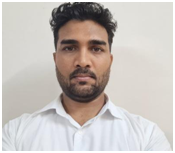
Dr. Shekhar Kumar Sahu is Coordinating this domain and serving as Assistant Professor in Agricultural Engineering in CUTM, Paralakhemundi. He obtained Ph.D. in Farm Machinery and Power Engineering specialization from IIT Kharagpur. He is conducting projects in the development of smart farm machinery. Some ongoing projects are the development of solar-operated smart planter and automatic […]

Dr. Bhabani Shankar Dash, Asst. is Professor (School of Agricultural and Bio. Engg.), Centurion University of Technology & Management (CUTM). He has obtained his Master’s degree in Farm Machinery and Power Engineering from GBPUA&T, Pantnagar (Agricultural Engineering). He has obtained the Ph.D. by working on Paddy Straw Management. In this domain he is taking course […]
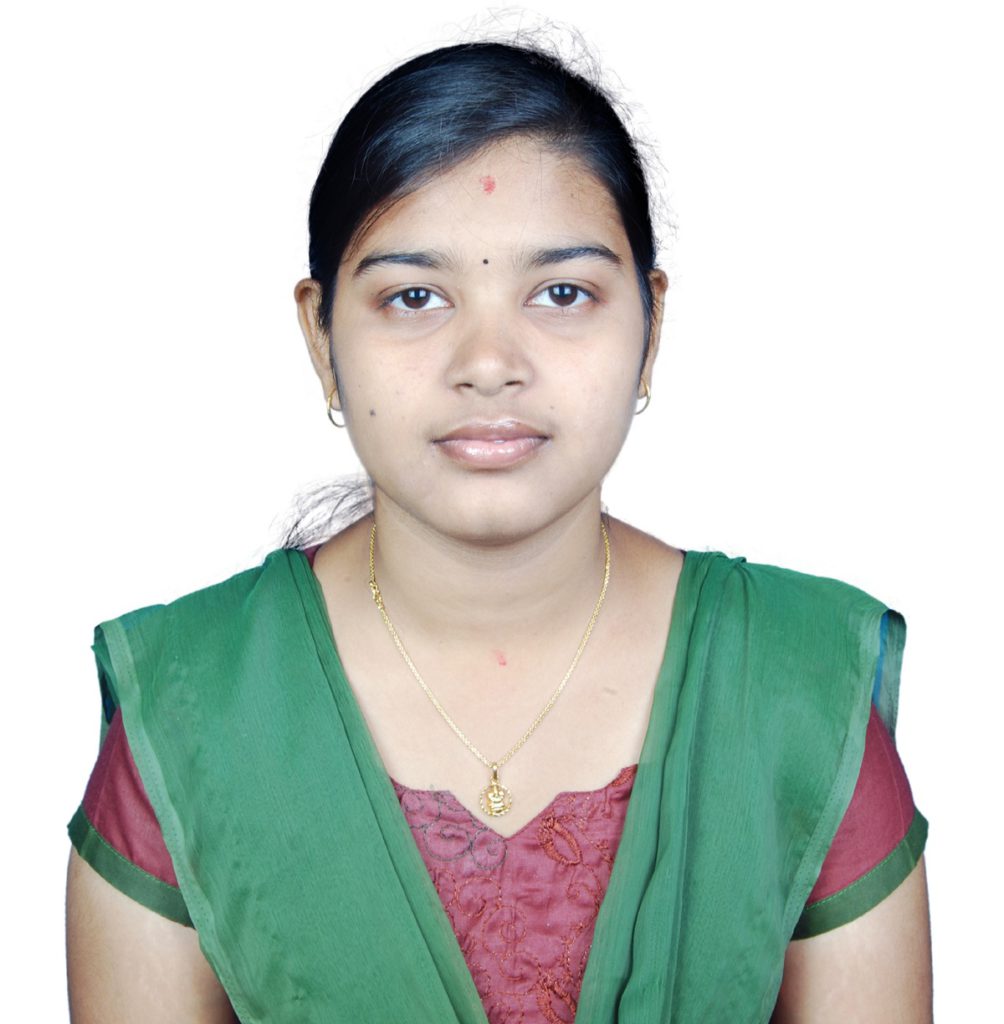
Ms. Sharmistha Sahu done M Tech in Farm Machinery and Power Engineering from Odisha University of Technology and Management. Working as an Assistant Professor in the Department of Agricultural Engineering (SoABE). CUTM, Paralakhumundi campus. She is guiding to the students smart engineering projects. Currently she is developing the tractor mounted smart weeder.

Dr. Mukundjee Pandey completed his B.Tech in Mechanical Engineering from Sikkim Manipal Institute of Technology Majitar East-Sikkim. He obtained his M. Tech. in Thermal Science and Heat Power engineering specialization from Institute of Technical Education and Research, Siksha ‘O’ Anusandhan University, Bhubaneswar in 2015. He has completed his PhD from International Institute of Information Technology, […]

